A groundbreaking study led by Juan Song, PhD, has made a big discovery. They found a way to make specific brain cells produce more neural stem cells and neurons. These cells are important for memory and emotions. This breakthrough shows that the adult brain can create new neurons, which could help improve thinking skills and treat brain disorders.
Neurogenesis, or the creation of new neurons, happens in adults in certain brain areas like the hippocampus. This area is key for memory and finding your way around. The human hippocampus has at least 27 different types of neurons, showing how complex it is.
Researchers used a technique called optogenetics in the SuM to boost neurogenesis. This led to more neural stem cells and new neurons1. This finding could lead to new ways to improve brain function.
This research could change how we treat many brain-related issues. Problems with creating new neurons in the adult hippocampus are linked to aging, diseases, and mental health issues1. By understanding and using neurogenesis, we might find new ways to keep our brains healthy as we age.
Key Takeaways
- Specific brain cells can be stimulated to increase the production of neural stem cells and neurons related to memory and emotion processing.
- The human hippocampus contains at least 27 different types of neurons, highlighting its complexity and diversity.
- Manipulating neural circuit activity can promote robust neurogenesis, increasing the production of neural stem cells and new adult-born neurons.
- Impaired adult hippocampal neurogenesis is associated with aging, neurodegenerative diseases, and mental disorders.
- Harnessing the power of neurogenesis may lead to novel strategies for cognitive enhancement and the treatment of neurological disorders.
Introduction to Neurogenesis in the Adult Brain
Adult neurogenesis, the creation of new brain cells, has changed how we see brain flexibility and thinking skills. It was once thought that the brain couldn’t make new neurons after birth. But now, we know certain parts of the adult brain, like the dentate gyrus and the subventricular zone, keep making new neurons2.
Researchers found neural stem cells in the adult brain that can turn into new neurons, brain support cells, and nerve cells. This discovery shows us how adult neurogenesis could help keep our brains working well and treat diseases2. We’re still learning how things like behavior and environment affect these new brain cells2.
“The human hippocampus retains its ability to generate neurons throughout life, as demonstrated by the presence of dividing progenitor cells in the dentate gyrus of adult humans.”3
Studies counted the number of new brain cells in different parts of the adult human hippocampus. They found differences in how many cells each person had3. Tests with special lights showed that these new cells were actually brain cells3.
Adult neurogenesis could greatly improve brain health and thinking skills. By using the brain’s ability to regenerate, we might find new ways to stop brain aging, treat diseases, and boost mental health.
| Neurogenic Region | Key Characteristics |
|---|---|
| Dentate Gyrus | Generates new granule cells in the hippocampus, involved in learning and memory |
| Subventricular Zone | Generates new neurons that migrate to the olfactory bulb, contributes to olfactory processing |
As we learn more about adult neurogenesis, it’s clear it’s very promising. It could greatly improve our understanding of how the brain works and help us find new ways to keep our brains healthy as we age.
The Discovery of Adult Neurogenesis
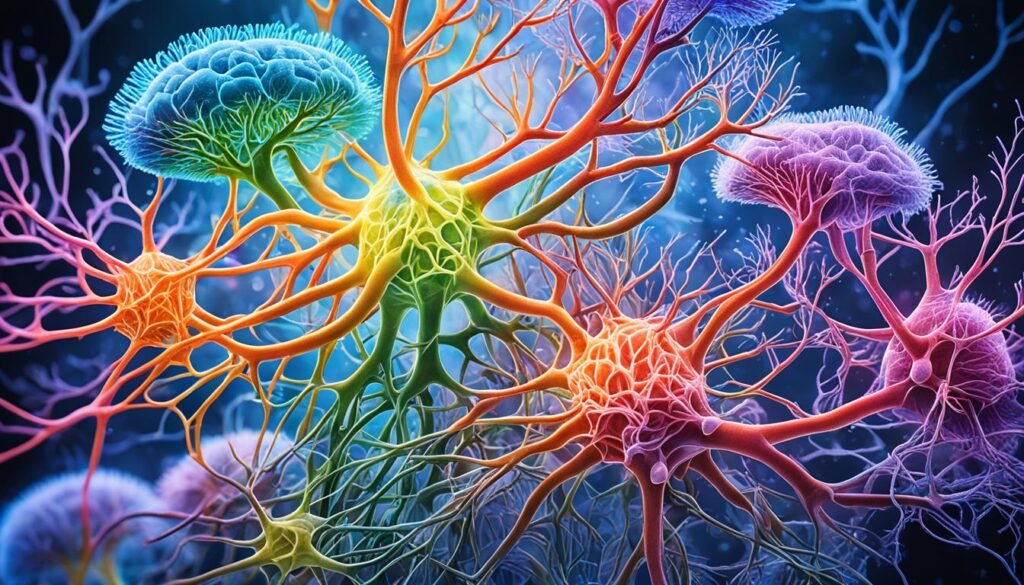
Adult neurogenesis has changed how we see the brain’s ability to change and heal. For a long time, scientists thought the brain couldn’t make new neurons after it was fully grown. But then, they found new neurons being made in certain parts of the adult brain. This discovery opened up new ways to study and help the brain heal.
Historical Perspective on Neurogenesis Research
Research in the 1960s first hinted at adult neurogenesis. Altman’s work in 1962 showed that certain brain areas in pigeons were making new cells4. This was a big step towards understanding brain regeneration.
Later, Altman and Bayer looked into how the brain developed after birth. They found that a key area for making new neurons was the hippocampus4. Their findings helped prove that adult neurogenesis was real.
Key Studies That Confirmed Adult Neurogenesis
In the late 1990s and early 2000s, some studies changed everything. Alvarez-Buylla and Nottebohm found new neurons moving in the adult bird brain4. This showed that neurogenesis wasn’t just for young brains.
Studies on human brain tissue showed that new neurons were being made in the adult brain too. These new neurons were found in the hippocampus, a key area for learning and memory.
| Study | Year | Key Findings |
|---|---|---|
| Boldrini et al. | 2018 | Human hippocampal neurogenesis persists throughout aging5 |
| Apple et al. | 2017 | Adult neurogenesis plays a significant role in psychiatric and cognitive disorders5 |
| Sahay et al. | 2011 | Increasing adult hippocampal neurogenesis can lead to improved pattern separation in cognitive tasks5 |
| Moreno-Jiménez et al. | 2019 | Adult hippocampal neurogenesis remains abundant in neurologically healthy individuals but declines sharply in patients with Alzheimer’s disease5 |
These studies proved that adult neurogenesis is real. They showed that the brain can keep making new neurons. This has opened up new ways to improve brain health and treat brain diseases.
Neurogenic Regions in the Adult Brain
The adult brain has areas that make new neurons, a process called adult neurogenesis. These areas, or niches, help neural stem cells grow, change, and join brain circuits6. New neurons are made in certain brain parts like the hippocampus and the subventricular zone (SVZ)7. The main places for making new neurons in mice are the ventricular-subventricular zone (V-SVZ) and the subgranular zone (SGZ) of the dentate gyrus6.
The hippocampus and the SVZ/OB are key places for making new neurons with different steps7. But, new neurons are also found in other brain areas like the hypothalamus, striatum, and cortex7. These new neurons might come from stem cells moving from the SVZ7.
The Subventricular Zone (SVZ)
The SVZ near the lateral ventricles is a key place for making new neurons in the adult brain. In rodents, these new neurons move to the olfactory bulb and become interneurons that help smell6. Adult stem cells in the V-SVZ make neurons that go to the olfactory bulb and the striatum6. Studies show that new neurons in other brain areas might help with metabolism, fat storage, and behavior7.
The Dentate Gyrus of the Hippocampus
The dentate gyrus in the hippocampus is another important place for making new neurons in adults. This process helps create new memories6. In the hippocampus, adult stem cells make only granule neurons in the dentate gyrus6. Making new neurons in the hippocampus goes through four stages: making cells, surviving early on, changing into neurons, and surviving longer7.
There is debate about if humans have adult neurogenesis in the hippocampus. But, research shows it does happen in the hippocampus and SVZ in adults6. Studying how new neurons join the adult brain is important for understanding memory and behavior6.
Adult-born granule cells help the hippocampal circuitry stay flexible for certain memories6.
Research on making new neurons in the adult brain has grown thanks to new methods. For example, a study used special mice to see how losing neurogenesis affects the brain8. This research helps us understand how making new neurons affects the brain and thinking6.
The Process of Adult Neurogenesis
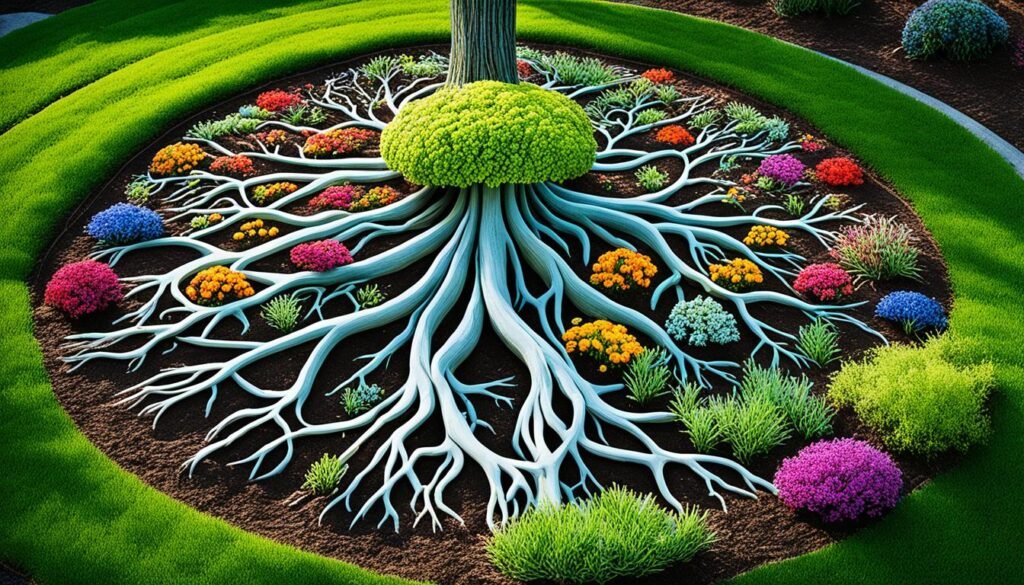
Adult neurogenesis is a process where new neurons are made from stem cells in the adult brain. This happens in many mammals, including humans, and helps the brain stay flexible and work well9. Finding neural stem cells in the adult mouse brain in 1992 showed us new ways to treat diseases like Alzheimer’s9.
Neural Stem Cells and Their Role in Neurogenesis
Neural stem cells are crucial for making new neurons. They can make more stem cells or neuroblasts, which turn into different brain cells9. These cells live in areas like the SVZ and SGZ in the brain9.
Studies found two kinds of stem cells in the hippocampus, each with a special job9. Exercise can also boost neurogenesis in the dentate gyrus, making more new neurons9. This shows how our lifestyle affects our brain health and thinking skills over time.
Stages of Neuronal Development in Adults
Adult neurogenesis has several steps, from making stem cells to adding new neurons to the brain9. In the SVZ, stem cells create C cells that turn into neuroblasts or A cells, which become neurons9.
After making new neurons, they must move to their spots in the brain, grow up, and connect with other neurons9. This process is key for the new neurons to work right and help the brain stay flexible and sharp.
Adult neurogenesis helps with learning, memory, mood, and spatial skills9. If it slows down, it can lead to problems with thinking and memory9.
Even though neurogenesis slows down with age and gets worse in some conditions, we can still use stem cells to help9. Research on this could lead to new ways to fight age-related brain decline and mental health issues9. For more info, check out the National Center for Biotechnology Information.
Factors Influencing Adult Neurogenesis
Adult neurogenesis in the brain changes based on many things, like our environment and lifestyle. These factors can help or hurt the growth of new brain cells. This happens mainly in areas like the subventricular zone (SVZ) and the subgranular zone (SGZ) of the dentate gyrus (DG) in the hippocampus10.
Environmental Factors Affecting Neurogenesis
Our environment greatly affects how many new brain cells we make. Exercise is a big factor here. Studies show that running can boost the number of new cells in the hippocampus of mice11. This helps improve learning and memory.
But, stress can slow down this process. Too much stress can cut down the number of new brain cells, especially in the hippocampus11. This might lead to problems with thinking and mood.
Environmental enrichment also helps. This means living in a world full of new things to see and do. Being in such an environment can help new brain cells survive and fit in better11.
Lifestyle Factors That Promote Neurogenesis
Our choices in life can also affect how many new brain cells we make. Eating well, with lots of omega-3 fatty acids, can help. So can special diets like eating less or fasting11.
Getting enough sleep is key too. Not sleeping well can hurt the growth and survival of new brain cells. But, enough sleep helps these cells grow and work right12.
Doing things that challenge your mind can also boost neurogenesis. Learning new things or solving tough problems can help new brain cells stick around and work better12.
| Factor | Effect on Adult Neurogenesis |
|---|---|
| Exercise | Increases neurogenesis in the hippocampus |
| Stress | Decreases neurogenesis, particularly in the hippocampus |
| Environmental Enrichment | Enhances the survival and integration of new neurons |
| Healthy Diet (e.g., omega-3 fatty acids) | Supports the production of new neurons |
| Sleep Deprivation | Impairs the production and survival of new neurons |
| Cognitive Stimulation | Promotes the survival and integration of new neurons |
Learning about what affects adult neurogenesis can help us find new ways to treat diseases. This could lead to new treatments for Parkinson’s, Alzheimer’s, depression, and schizophrenia10.
The Role of Adult Neurogenesis in Cognitive Function
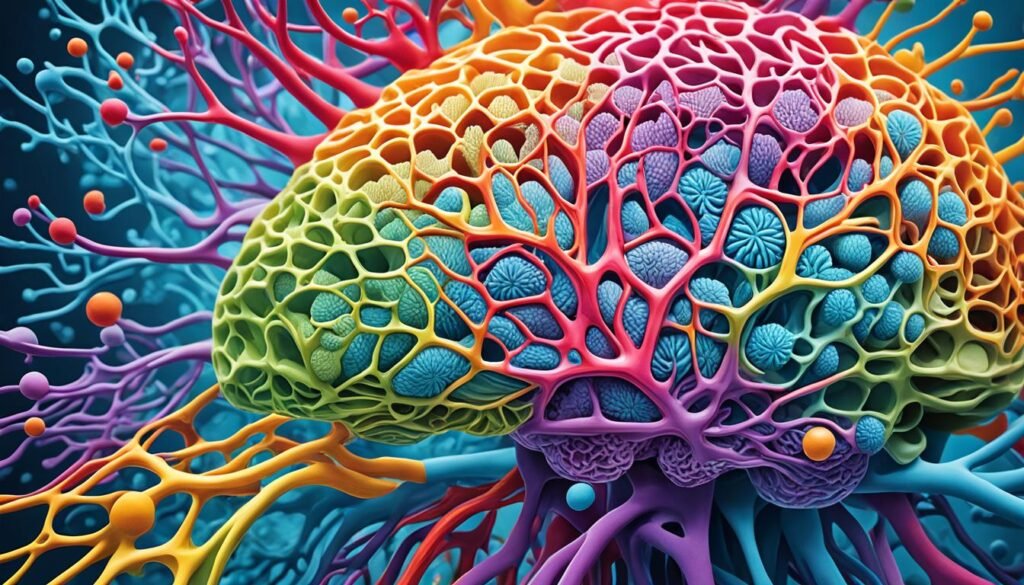
Adult neurogenesis has changed how we see the brain’s ability to grow and adapt. It shows that the brain can keep growing even as an adult. This growth is key for learning, remembering things, and keeping different memories separate13.
Studies show that learning can affect how many new brain cells we make. This can go up or down, based on when these cells are born14. This shows how our brain’s ability to grow changes with our learning and thinking.
By doing mentally challenging tasks and learning new things, we can use neurogenesis to boost our brain power. This keeps our brain healthy and able to adapt as we age.
The hippocampus, a key area for learning and memory, keeps making new neurons in adults. This helps our brain stay flexible and adaptable.
Adult neurogenesis also helps us keep similar memories separate13. This is important for remembering things clearly without mixing them up. As we keep making new neurons, our memory gets better at making these distinctions.
- Adult neurogenesis helps make and strengthen new memories
- Learning can change how fast we make new brain cells
- It helps us keep different memories separate
We’re still learning about how adult neurogenesis affects our brain. But, it seems clear that new neurons play a big part in learning, remembering, and keeping memories distinct1413. As we learn more, we might find new ways to improve our brain and treat memory problems.
Neurogenesis and Brain Plasticity
The adult brain’s ability to change and adapt shows its amazing plasticity. This comes from two main processes: making new neurons and changing connections between them. These help the brain change and grow in response to new things, learning, and challenges. This makes it flexible and resilient throughout life15.
How Neurogenesis Contributes to Neural Plasticity
Neurogenesis is how the adult brain makes new neurons. These new neurons help form new connections and circuits16. This process helps the brain adapt and change with new experiences and learning15. It’s key for keeping the brain working well and staying healthy as we age17.
Adults make new neurons at a slower rate than kids, but it’s still important for brain health16. New neurons in areas like the hippocampus help with learning and remembering things15. This keeps the brain ready to learn new things and adapt to changes17.
The Relationship Between Neurogenesis and Learning
Learning new things is closely linked to making new neurons. Activities that challenge the brain help these new neurons survive and join in with other neurons17. This makes the connections between neurons stronger, helping the brain learn even more in the future15.
New neurons in the hippocampus also help with adapting to new situations16. They give the brain the chance to change and grow in response to new challenges. This shows how important it is to keep learning and trying new things for a healthy brain15.
| Neurogenesis | Synaptic Plasticity |
|---|---|
| Birth of new neurons in the adult brain | Strengthening or weakening of connections between existing neurons |
| Contributes to structural plasticity | Underlies functional plasticity |
| Provides fresh neural resources for learning and adaptation | Enables the brain to adapt and reorganize in response to experience |
| Occurs in specific regions like the hippocampus and subventricular zone | Occurs throughout the brain, modifying neural circuits |
In conclusion, the connection between neurogenesis and brain plasticity is key to staying adaptable and resilient. They work together to support learning, memory, and flexibility. By doing mentally stimulating activities, exercising, and living a healthy life, we can keep our brains working well throughout our lives171615.
Strategies to Stimulate Adult Neurogenesis
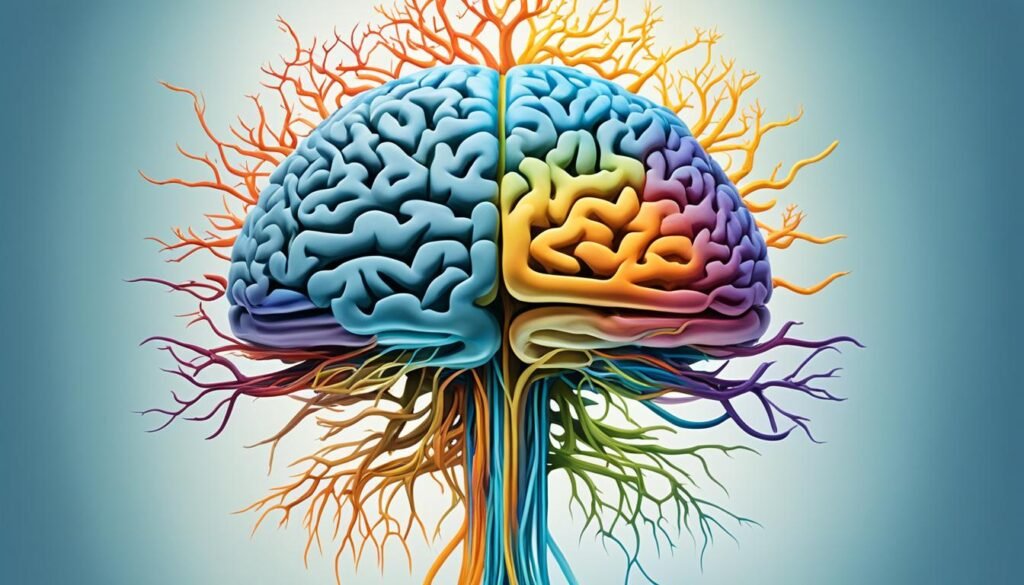
Exploring adult neurogenesis shows us how to grow new brain cells. We can do this through exercise, diet, and mental activities. These methods help our brain regenerate and improve.
Physical Exercise and Neurogenesis
Regular exercise, especially cardio, boosts adult neurogenesis. Running, for example, made more new cells in mice brains18. It also made the hippocampus bigger in 120 elderly people with dementia18.
Exercise makes brain factors like BDNF and IGF-1. These help new neurons survive and grow as a study found.
Dietary Interventions to Boost Neurogenesis
What we eat affects our brain’s growth. Eating less and fasting can help make new brain cells in animals19. These include fasting for 16 hours a day or once a week19.
Eating foods with omega-3 fatty acids, like DHA, also helps. Other foods that can boost brain growth include:
- Flavonoids in cocoa, blueberries, oolong, and green teas18
- Chlorogenic acid in coffee and black tea18
- Resveratrol in red wine and grapes18
- Curcumin in turmeric18
| Dietary Intervention | Effect on Neurogenesis |
|---|---|
| LMN diet | Increased neurogenesis in mice and a mouse model of Alzheimer’s18 |
| Omega-3 fatty acid DHA | Increased new connections in the hippocampus18 |
| Phosphatidylcholine | Stopped the decrease of hippocampal neurogenesis in mice18 |
| Melatonin | Promoted neurogenesis in the hippocampus in animal studies18 |
Cognitive Stimulation and Neurogenesis
Doing mentally challenging tasks and exploring new places can help grow new brain cells. Learning new skills keeps new neurons alive in the hippocampus18. Traveling to new places also boosts neurogenesis19.
Learning a new instrument can also help grow neurons, especially if started young19.
Reading novels makes brain activity better, especially in areas for feelings and movements19.
By living a life with exercise, a diet that supports brain health, and mental challenges, we can use adult neurogenesis to improve our brains. As we learn more, we see more ways to help our brains regenerate and fight diseases.
Potential Therapeutic Applications of Adult Neurogenesis
Adult neurogenesis has opened new doors for treating neurological and psychiatric disorders. It shows the brain can make new neurons. Researchers aim to use this to treat conditions where neurons are lost or don’t work right. Let’s look at how adult neurogenesis could help with neurodegenerative diseases and mental health issues.
Neurogenesis in Neurodegenerative Diseases
Diseases like Alzheimer’s and Parkinson’s cause neurons to die and make less new ones. By 2030, more people might get these diseases because more people are living longer20. Alzheimer’s disease is expected to get worse, with more people getting it20. Right now, there’s no cure for these diseases20.
Boosting neurogenesis might help these diseases by replacing lost neurons and improving brain function. Using stem cells has shown promise in treating Parkinson’s disease20. But, it’s not always successful in stopping the disease from coming back20.
These diseases are complex and affect more than just neurons. They can start showing symptoms before many neurons are lost20. Now, researchers focus on supporting brain cells instead of just replacing them20. We need to improve how adult stem cells work to treat these diseases better20.
Targeting Neurogenesis for Mental Health Disorders
Adult neurogenesis might help with depression and anxiety. Some antidepressants make more neurons in the hippocampus. This suggests that boosting neurogenesis could be a way to treat these mood disorders.
A study in 2002 found new neurons in the adult hippocampus21. This is important because the hippocampus helps with mood and stress. It shows how neurogenesis could play a big role in mental health.
Trametinib, a drug that targets certain pathways, increased new neurons in mice with Alzheimer’s disease22. It helped fix brain damage and improve thinking in these mice22. This shows that targeting certain pathways in neurogenesis could be a new way to treat mental health issues.
We need to learn more about how neurogenesis affects mental health. By understanding this, we can create new treatments. Using adult neurogenesis could lead to better ways to help people with mental health problems.
Challenges and Limitations in Adult Neurogenesis Research
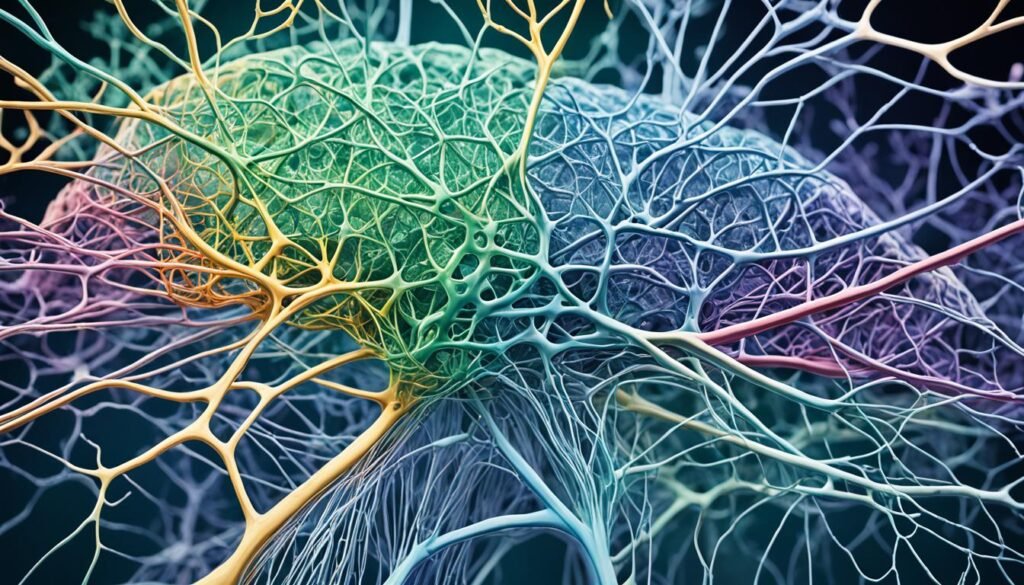
Adult neurogenesis research is exciting but faces many challenges. One big issue is studying it in the human brain directly. This needs postmortem tissue or advanced imaging23. Sorrells et al. used postmortem samples from 37 controls and 22 epilepsy patients, showing the limited tissue available23.
Another challenge is understanding markers for new neurons. Sorrells et al. used DCX and PSA-NCAM to spot new neurons in young children’s brains23. But, these markers’ accuracy is debated due to postmortem delay and tissue processing effects23. For example, DCX signal drops fast in bats, and cell death can change cell traits quickly23.
There are also barriers when trying to apply animal study results to humans. Adult neurogenesis in humans is still unclear, unlike in rodents. Sorrells et al. found little neurogenesis in adults, but Boldrini et al. saw many DCX-positive cells in human tissues23. This shows we need more research on human adult neurogenesis.
Technical challenges also come from comparing studies and species. Different methods and protocols can lead to varied results. For instance, Sorrells et al. used three tissue sections per hippocampus, but others might use different methods23. Standardizing methods is key to understanding adult neurogenesis better.
To tackle these issues, researchers are exploring new technologies. Non-invasive imaging like MRI and PET can study neurogenesis in humans. Using human iPSCs and organoids also helps study neurogenesis in a controlled way. With these tools and careful designs, researchers can better understand adult neurogenesis and its effects on brain health and cognitive enhancement.
Future Directions in Adult Neurogenesis Studies
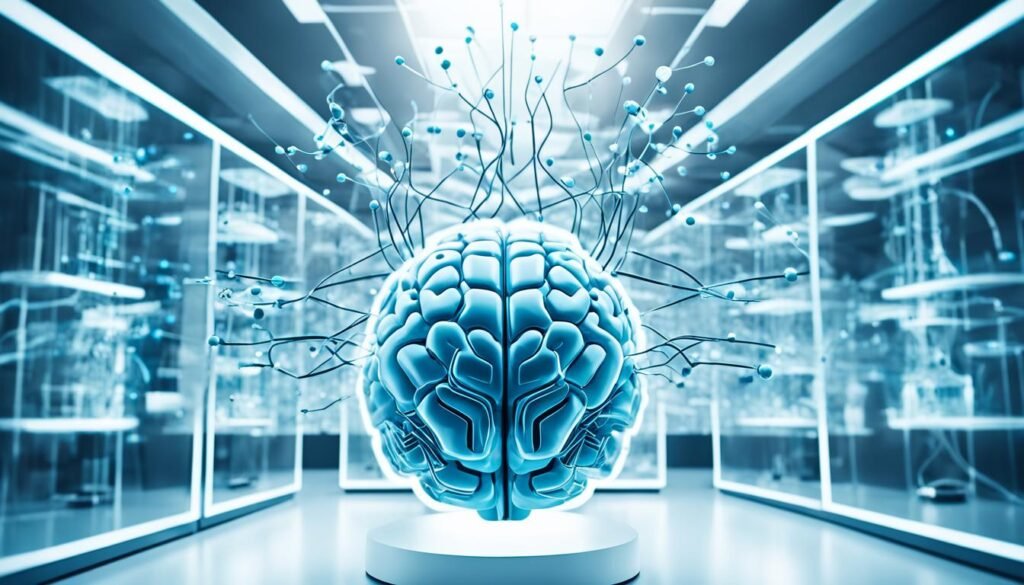
Our understanding of adult neurogenesis is growing fast. Researchers are now looking into new ways to study this complex process. They’re using new technologies and methods to make big discoveries and find new treatments.
Emerging Technologies to Study Neurogenesis
New tech has changed how we study adult neurogenesis. Single-cell sequencing lets us see specific cells involved in making new brain cells. Optogenetics uses light to control brain cells, showing how new neurons work in the brain. In vivo imaging shows us how neurogenesis happens in real time.
These new tools have brought big discoveries. For example, they’ve found different types of stem cells and how they work. Studies show how new neurons help with learning and memory24.
Translating Neurogenesis Research into Clinical Applications
The goal is to use what we learn about adult neurogenesis to help people. Researchers want to find ways to treat diseases like Alzheimer’s and depression with it. They’re looking at how to make the brain heal itself.
One way is through regenerative medicine. This could use stem cells to replace damaged brain cells. By putting stem cells in the brain, researchers hope to grow new neurons that work well with others24.
Another way is through drugs that help neurogenesis. For example, a drug for Alzheimer’s also helps make new brain cells24. This shows that drugs might help improve brain function and treat diseases.
Personalized medicine is also being explored. It looks at how each person’s brain can make new cells differently. By understanding this, researchers can make treatments that work best for each person.
| Emerging Technology | Key Applications in Neurogenesis Research |
|---|---|
| Single-cell sequencing | Identification and characterization of specific cell types involved in neurogenesis |
| Optogenetics | Precise control of neural activity to study the functional role of adult-born neurons |
| In vivo imaging (e.g., two-photon microscopy) | Real-time monitoring of neurogenesis dynamics in living organisms |
The future looks bright for adult neurogenesis research. By using new tech and focusing on practical applications, we could see big improvements in brain health and thinking skills. Researchers are working hard to bring these discoveries to life.
The Importance of Neurogenesis for Brain Health and Cognitive Enhancement
Adult neurogenesis is key to keeping our brains healthy and sharp. It’s the making of new neurons in our adult brains. Activities like exercise, learning new things, and eating well can boost the creation of these new brain cells25. These habits help grow new brain cells and build a strong cognitive reserve. This reserve protects us from losing brain function as we age and helps fight diseases26.
Adult neurogenesis does more than just add new neurons. It helps these new cells join the brain’s networks. This is vital for learning, remembering things, and adapting to new situations27. By adding new neurons to the hippocampus and other areas, we improve how we handle new info, make memories, and adjust to changes. This keeps our brains flexible and strong over time.
There are big hopes for using adult neurogenesis to help with diseases and mental health issues. By making more new neurons, we could fight Alzheimer’s, Parkinson’s, depression, and anxiety26. This could change how we care for our brains, helping us stay sharp and even improve our thinking skills. As we learn more about adult neurogenesis, it’s clear that supporting this process is key to keeping our brains in top shape.
FAQ
What is neurogenesis, and does it occur in the adult brain?
Neurogenesis is the creation of new brain cells. It was once thought to stop after birth. But now, we know it keeps happening in certain areas of the adult brain, like the hippocampus and the subventricular zone.
What are the main neurogenic regions in the adult brain?
The main places where new brain cells grow in adults are the subventricular zone and the dentate gyrus. In the subventricular zone, new cells move to the olfactory bulb and help with smell. In the dentate gyrus, they help make new memories.
How does adult neurogenesis contribute to brain plasticity and cognitive function?
Adult neurogenesis helps the brain change and adapt. It creates new connections and circuits. This helps the brain learn, remember, and keep track of different things.
What factors can influence the rate of adult neurogenesis?
Many things can change how fast new brain cells grow. Exercise, stress, and a rich environment can help. Eating well, sleeping enough, and staying mentally active also boost it. Exercise, especially heart-based activities, helps make factors that support new neurons.
What are the potential therapeutic applications of adult neurogenesis?
Boosting adult neurogenesis could help with diseases like Alzheimer’s and Parkinson’s by replacing lost brain cells. It might also help with depression and anxiety. Some medicines already increase new cell growth in the brain.
What challenges and limitations exist in adult neurogenesis research?
Studying adult neurogenesis in humans is hard because we can’t easily see the brain. It’s not clear how much it happens in humans or what it does. Moving from lab studies to human treatments is also tricky.
What are the future directions in adult neurogenesis studies?
Researchers want to use what we learn about adult neurogenesis to help with diseases and mental health issues. New tools like single-cell sequencing and in vivo imaging are giving us more insights. Personalized treatments might make these therapies more effective.
How can I promote adult neurogenesis to maintain brain health and cognitive function?
Doing things that help brain cell growth, like exercising, staying mentally active, and eating well, can keep your brain healthy. These actions can protect against age-related brain decline and improve thinking skills.
